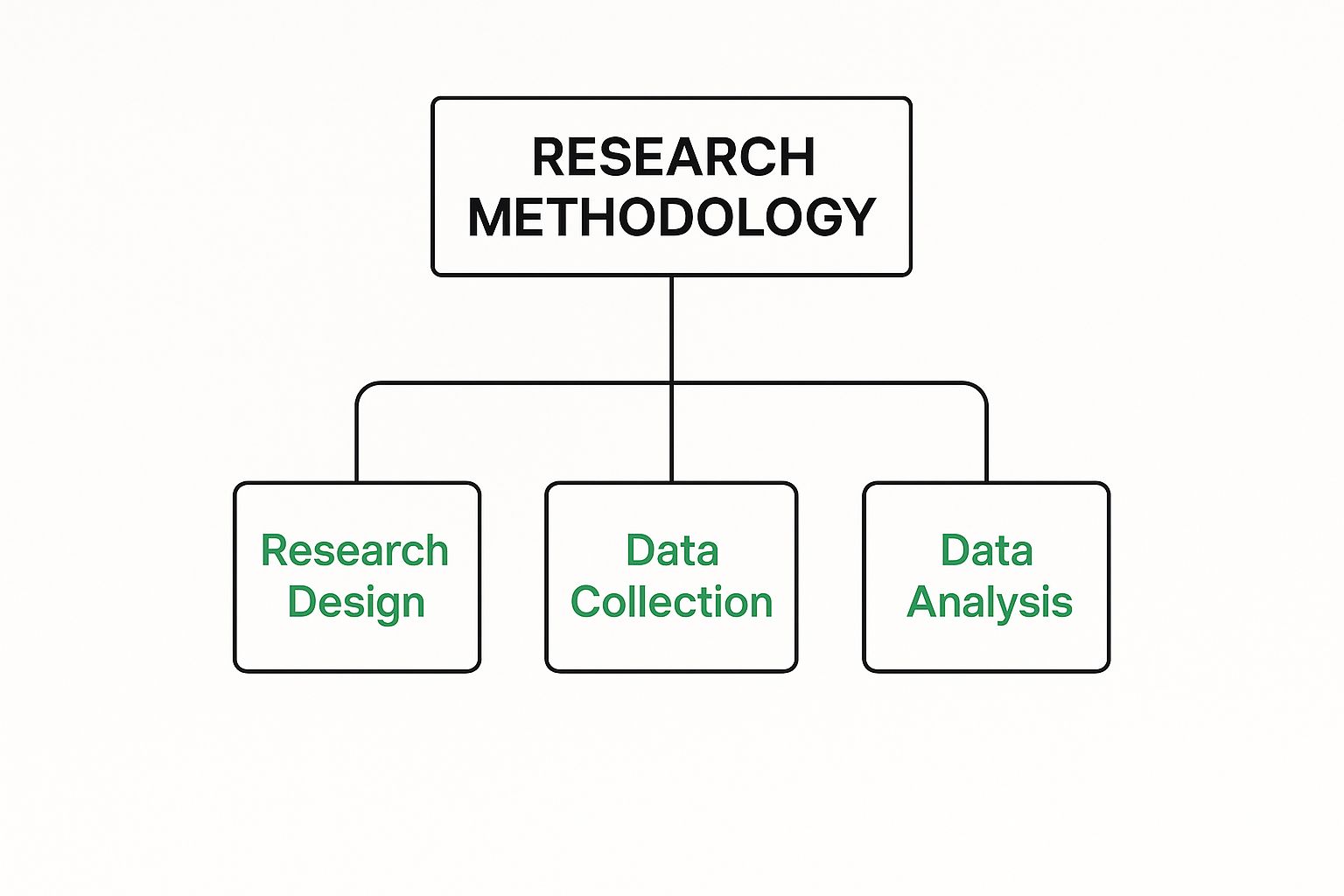
What Is an Outline of a Research Paper & How to Write It
October 8, 2025
A research paper outline is your blueprint for success. Think of it as the strategic framework that organizes all your ideas, arguments, and evidence before you even start writing the first draft. It’s like an architect’s plan for a skyscraper; it ensures every single part has a purpose and connects logically to the whole, preventing you from discovering a major structural weakness halfway through the build.
Your Blueprint for a Successful Research Paper

Jumping straight into writing a research paper is like trying to navigate a new city without a map. Sure, you might get to your destination eventually, but you’ll probably hit a dozen dead ends, take some long detours, and waste a ton of time in the process. An outline is that map. It gives you a clear, direct path from your introduction all the way to your conclusion.
This isn't just some optional first step. For seasoned academics and top students, the outline is often the most critical tool for turning a chaotic collection of notes and sources into a clear, logical narrative.
The Strategic Value of Planning
At its core, an outline’s job is to bring order to complexity. When you map out your main points and the sub-points that support them, you can literally see how your arguments fit together.
This is the stage where you spot the gaps in your research, notice if an argument feels a bit thin, and make sure the whole thing flows logically. And you get to do all that before investing hours writing paragraphs you might just have to delete later.
An outline forces you to think critically about your paper's structure. It’s where you decide on the most effective way to present your information, ensuring that each section builds on the last to create a powerful, persuasive argument.
This structured approach really works. Studies have found that consistently using an outline can boost writing efficiency by 30-40% and dramatically improve the logical flow of the final paper. It also breaks the intimidating task of writing a huge paper into smaller, more manageable pieces—a proven strategy for beating writer's block. For more on this, check out these insightful pedagogical reports on academic writing structure.
To give you a quick overview, here's a look at the key sections you'll typically map out.
Key Components of a Standard Research Paper Outline
This table breaks down the essential parts of a research paper outline, helping you see how each piece contributes to the overall structure.
| Section | Purpose in the Outline |
|---|---|
| Introduction | State your thesis, provide context, and briefly preview the main points. |
| Literature Review | Summarize existing research and identify the gap your paper will fill. |
| Methodology | Detail the methods and tools used to conduct your research. |
| Results/Findings | Present the data and key findings without interpretation. |
| Discussion | Interpret your findings, explain their significance, and connect them to your thesis. |
| Conclusion | Summarize your argument, restate your thesis, and suggest areas for future research. |
This structure acts as your guide, ensuring every part of your paper has a clear purpose.
What an Outline Accomplishes
Ultimately, creating a solid outline gives you a huge advantage. It's not just about organization; it directly improves the quality of your final draft in several key ways.
- Ensures Cohesion: It tethers every section of the paper back to your central thesis statement, making sure every paragraph is doing its job.
- Improves Organization: It helps you arrange your ideas in a sequence that makes sense, whether that’s chronological, thematic, or by order of importance.
- Saves Time: Catching structural problems early on saves you from hours—or even days—of frustrating rewrites down the line.
- Builds Confidence: Working from a clear plan gets rid of that "blank page anxiety" and empowers you to write with direction and purpose.
Mastering this stage will fundamentally change the way you write for the better, making the entire process smoother and your final paper far more impactful.
The Strategic Benefits of Outlining Your Research

When you're eager to start writing, taking time to build an outline can feel like a detour. But trust me, it’s one of the smartest strategic moves you can make. Think of your outline as the GPS for your research paper. It gives you a clear path from your introduction to your conclusion, so you don't get lost on weird tangents or wander down intellectual dead ends.
This planning stage is your first line of defense against messy structural problems. By mapping everything out, you can immediately see where your arguments are strong and where they need more support. It’s a whole lot easier to rearrange a few bullet points than it is to rewrite entire pages of prose.
Gain Clarity and Defeat Writer's Block
A solid outline brings a huge amount of clarity to your project. It turns the terrifying task of writing a ten-page paper into a series of small, manageable steps. Instead of staring at a blank page, you’ve got a clear to-do list of points to tackle one by one. This approach is a proven killer of writer's block.
And it’s not just about this one paper. The process of creating an outline is an invaluable part of building essential study skills that pay off across the board. The benefits ripple out, improving how you approach complex tasks in any field.
An outline is more than an organizational tool; it’s a diagnostic tool. It allows you to test the logical integrity of your arguments and identify gaps in your evidence before you commit significant time to writing.
Improve Your Academic and Professional Outcomes
The impact of a great outline is real and measurable. When you make sure every argument connects logically to your thesis, you create a paper that’s coherent and persuasive. This translates directly into better comprehension for your readers—and, let's be honest, usually means higher grades from instructors.
The benefits are even clearer at the professional level. A 2023 analysis from the National Center for Science and Engineering Statistics (NCSES) found something pretty stunning: research papers developed with pre-submission strategies, including detailed outlines, have 25% higher acceptance rates in peer-reviewed journals. This shows that investing in structure isn’t just good practice; it's a key differentiator for success. You can dig into the full publication output data on the NCSES site to see the numbers for yourself.
Deconstructing the Anatomy of a Research Outline
Alright, we’ve covered the "why." Now let's get into the "what" and break down a standard research outline, piece by piece.
Think of it like an architect's blueprint. You wouldn't start building a house without knowing where the walls, doors, and support beams go. Each section of your outline serves a specific function, and they all work together to create a solid, logical structure for your paper.
A typical research paper outline has a few core components that mirror the final document: an Introduction, Literature Review, Methodology, Results, Discussion, and Conclusion. Understanding what each part is meant to accomplish is the first step to building a framework that won't fall apart later.
The Foundational Sections Explained
Your outline kicks off by mapping out the introduction. This isn't just a placeholder; it's where you'll anchor your thesis statement—the central argument that your entire paper is built around. Your outline for the intro should also sketch out the key background points you’ll use to set the stage for your reader.
Next up is the Literature Review. In your outline, this section is like building a library of existing knowledge. You'll list the key studies, theories, and scholarly conversations that are relevant to your topic. The real goal here is to pinpoint the "gap" in the current research that your own work is going to fill.
The Methodology is the "how-to" guide for your entire project. It’s where you'll jot down the precise steps and procedures you plan to follow. This isn't just for you; it's about showing others how you got your results.
The infographic below shows the three pillars you'll need to think about when outlining your methodology.

As you can see, your overall research design informs how you'll collect your data, which in turn dictates how you'll analyze it. Each piece depends on the others, creating a research strategy that's clear and, most importantly, defensible.
Mapping Out Your Findings and Arguments
Following the methodology, the Results section in your outline is pretty straightforward. You're simply listing the key findings or data points that came out of your research. The crucial part? This section is purely descriptive. You just present the facts and save all the interpretation for the next part.
The Discussion is where the magic happens. This is where your analysis truly comes to life. Your outline for this section should map out the main arguments you’ll build from your findings. How do your results answer your original research question? What are the bigger implications? You're connecting the dots for your reader here.
Your outline’s Discussion section acts as a rehearsal for your final argument. It’s a low-stakes environment to test the logical flow of your interpretations before committing them to prose.
Finally, the Conclusion brings it all home. In your outline, you’ll plan a quick summary of your key points, restate your thesis (now backed by evidence), and maybe offer a few suggestions for future research. A well-planned conclusion ensures your paper ends with impact, not a whimper.
While they both summarize, a conclusion is different from a preliminary overview. If you need help crafting those short, punchy academic summaries, our guide on how to write an abstract is a great place to start.
How to Build Your Research Paper Outline Step-by-Step
Alright, we’ve covered the theory. Now it’s time to get your hands dirty and turn that messy collection of ideas, notes, and sources into a clean, actionable plan. Building an outline is where your research starts to take real shape, moving from broad concepts to a detailed, layered structure. Think of it as drawing the blueprints before you start building the house.
This whole journey kicks off with your core research question. The very first thing to do is hammer that question into a sharp, concise thesis statement. This one sentence becomes the North Star for your entire paper. Seriously, every single point, argument, and piece of evidence in your outline must connect back to it.
Once your thesis is locked in, pull together all your notes and sources. It's time to play matchmaker. Start grouping related ideas into logical clusters. For instance, everything about that one specific experiment? Put it in a pile. All the notes on a particular author's theory? They go together. You’ll start to see the natural structure of your argument emerge right from your research. Our detailed guide on how to write a literature review can be a huge help here for organizing those sources.
Choosing Your Outline Format
With your ideas clustered, you need to decide how to format your outline. This choice is all about how you visually organize the hierarchy of your information. The two most common formats are Alphanumeric and Decimal, and each has its own vibe depending on your paper's complexity.
Pro-Tip: Don't get paralyzed by the format choice right now. The most important part is establishing a clear hierarchy. You can always switch it up later if one style feels more intuitive as you go.
For some solid, practical advice on structuring different kinds of academic writing, you might find this guide on the best way to write an essay report pretty useful.
Now, let's break down the two main styles so you can pick the right one for your project.
Alphanumeric vs Decimal Outline Formats
Picking a format isn't just about looks; it's about what works best for your brain and your topic. This table compares the two most popular outline formats to help you decide which style is the right fit.
| Feature | Alphanumeric Outline (I, A, 1, a) | Decimal Outline (1, 1.1, 1.1.1) |
|---|---|---|
| Structure | Uses a classic mix of Roman numerals, letters, and numbers to show levels of importance. | Uses a slick numerical system where each sub-level just adds a decimal point. |
| Best For | Traditional papers in humanities and social sciences. It's visually intuitive for most people. | Complex technical or scientific papers where you need precise section numbering. |
| Clarity | Super clear for about four levels of detail, but can start looking a little clunky after that. | Infinitely scalable. It’s a lifesaver for cross-referencing (e.g., "See section 2.3.4"). |
| Example | I. Main Point A. Sub-point 1. Supporting Detail |
1. Main Point 1.1. Sub-point 1.1.1. Supporting Detail |
Ultimately, both get the job done. The Alphanumeric style feels more traditional and is often easier to skim, while the Decimal style offers a kind of surgical precision that's perfect for dense, multi-part arguments.
Once you've picked your format, you can finally start populating the structure. Begin with the big-ticket sections: Introduction, Methodology, Discussion, and so on. Then, slot your key arguments under each one as sub-points, and follow those up with the specific evidence, data, or citations that back them up. This layered approach ensures you have a functional, detailed blueprint ready to guide your first draft with confidence.
Digital Tools and Techniques for Modern Outlining
Sure, there’s a certain charm to sketching out an outline with pen and paper, and for some, that will always be the way to go. But let’s be honest: today’s digital tools can make the process faster, more flexible, and a whole lot less messy.
Modern software turns your outline from a static list into a living document. It's like having a digital whiteboard where you can drag ideas around, nest thoughts under bigger concepts, and collaborate with others without a single eraser smudge.
This shift has made a real difference. By 2020, it was estimated that over 75% of researchers were already using software like Microsoft Word, Scrivener, or mind-mapping apps to build their outlines. The switch reportedly cut down their planning time by a solid 20-25%. If you’re curious, you can dig into the numbers behind these productivity findings in academic research.
Choosing Your Outlining Software
There’s no single "best" tool—it all comes down to what clicks with your brain. What works for a visual thinker might just frustrate someone who prefers a simple, linear list.
For a lot of people, the outlining feature already built into Microsoft Word is more than enough to get started. It’s straightforward and gives you a simple, hierarchical structure without any fuss.
But if you’re tackling a bigger, more complex project, dedicated writing apps are where the real magic happens.
- Mind-Mapping Tools (Miro, XMind): Perfect for visual thinkers. Instead of a top-down list, you create a web of interconnected ideas. It’s a fantastic way to see how different parts of your research connect in a way a linear list just can’t show you.
- Dedicated Writing Apps (Scrivener): Tools like Scrivener are built from the ground up for long-form writing. They let you keep your outline, research notes, and drafts all in one place, which is a lifesaver for massive projects.
Here’s a look at Scrivener’s interface. It uses a "corkboard" view that lets you treat each section of your outline like an index card.
This is incredibly helpful. You can spot gaps in your argument or try out a different flow just by dragging and dropping a few cards. It's simple, visual, and powerful.
The best digital tool is the one that gets out of your way. It should make organizing your thoughts feel intuitive, not like you’re learning a complicated new piece of software.
As you start using these tools, just remember that the goal is still a clear, original paper. To make sure your final draft doesn't sound robotic or stiff, you might want to check it for that all-too-common AI feel. Our guide on using an AI writing checker has some great tips for refining your text so it reads with a genuine human touch.
At the end of the day, these digital aids are there to help you build a stronger, more flexible research paper outline.
Still Have Questions About Research Paper Outlines?

Even after you get the "what" and "why" of outlining, the "how" can still feel a bit fuzzy. It’s one thing to understand a concept and another thing entirely to put it into practice when you're staring at a blank page.
Let's clear up the most common sticking points. Think of this as a quick troubleshooting guide for the questions that inevitably pop up when you start building your own outline.
How Detailed Should My Outline Be?
This is the big one. And the honest answer? It depends. The perfect outline is a balancing act—it needs to be detailed enough to guide you but not so rigid it kills any new ideas that come up during writing.
A good rule of thumb is to shoot for at least two or three levels of hierarchy. That means you have your main sections (Level 1), the core arguments inside each section (Level 2), and the specific evidence you’ll use to back them up (Level 3).
- A high-level outline is just a basic sketch. It lists your main sections (Introduction, Methods, etc.) and your thesis. It’s a great starting point for brainstorming, but it’s not enough to get you through the first draft.
- A detailed outline is the goal for most academic work. This is where you add sub-points for each section, note specific sources or data, and maybe even jot down topic sentences for your most important paragraphs.
You'll know your outline is detailed enough when you can glance at any section and know exactly what you need to write. No more stopping mid-sentence to rethink your entire argument.
Topic Outline vs. Sentence Outline
Another common point of confusion is whether to use a topic outline or a sentence outline. They’re both great formats, but they serve slightly different needs and suit different writers.
A topic outline uses short phrases or even single words. It’s fast, easy to create, and gives you a bird's-eye view of your paper's structure, which makes rearranging ideas a breeze.
For example:
- I. Introduction
- A. Hook: Alarming plastic waste stat
- B. Thesis: Biodegradable alternatives
- C. Paper overview
A sentence outline, on the other hand, uses complete sentences for every single point. This forces you to get crystal clear on your thinking from the very beginning. It takes more time upfront, but it’s essentially a detailed summary of your entire paper.
A sentence outline is so powerful because it makes you articulate the specific claim for each entry. By the time you’re done, you’ve basically written the logical core of every single paragraph.
It really comes down to personal preference. If you like to organize your thoughts quickly, start with a topic outline. If you want to make sure your logic is rock-solid before you even start drafting, the sentence outline is your best bet.
Can I Change My Outline After I Start Writing?
Absolutely. In fact, you should. Your outline isn’t a contract set in stone; it’s a living, breathing document.
Writing is a process of discovery. As you start to build out your arguments, you'll find new insights, stumble upon stronger evidence, or realize a different structure would be way more persuasive. That's a good thing!
Think of your outline as a flexible guide, not a cage. Here’s when it’s smart to circle back and make a change:
- A better structure emerges: You might realize that flipping two of your sections creates a much more compelling story for the reader.
- Your research takes an unexpected turn: Maybe you find a groundbreaking study that challenges your initial thesis. Great! Adjust your argument.
- You spot a weak point: As you're writing, you might notice a section is thin on evidence. That’s your cue to either dig up more support or merge that point with a stronger one.
Don't ever be afraid to hit pause on the writing, jump back to your outline, and make adjustments. This back-and-forth between outlining and drafting is what turns a decent paper into a great one.
Creating a clear, human-sounding research paper is challenging, especially when you've been staring at AI-generated drafts. Natural Write can help you transform robotic text into polished, natural prose that passes any AI detector. Polish your work with confidence at https://naturalwrite.com.


